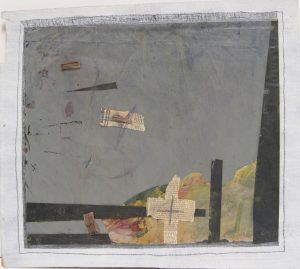What colour can a dream be? (Marina De Stasio, 1996)

For Monika Wolf painting is first and foremost a means to express oneself and to communicate; it is a process that begins with a sign, in other words, that starts from a form of writing which brings directly to the surface, without any filtre, an interior movement, and then finds form, depth, and complexity through the action of colour; a progression from a directly expressive sign to a more reflected-on, and sought-after colour.
What colour can a feeling or a concept be? What colour can a dream be? What, in a word, is the colour of the invisible?
Art has always posed this question; every artist has his or her answer. For Wolf, colour can also subvert relations between forms: a solid dark form associated with a smaller form in a more pastel colour can give a sensation of constriction, of pressure, while harmony of signs and colours can communicate a sense of repose, of peace.
Although the composition can suggest the space of a landscape or an enclosed space or the appearance of a figure, overall it tends towards the abstract, not because it seeks a solely external effect of pure construction or decoration, but on the contrary in order to obtain maximum freedom to use the tools of painting to create communication and dialogue: through simbols which come into beeing through the artists activity, there is a search to express in figurative form the events of the artist’s interior life. In this sense the artist’s work can be seen as post-informal, and specifically as one evolution of that particular informal movement which Wols and Cy Twombly, among others, belong to, and which has its roots in Surrealism, in other words in a view of art as a direct manifestation of the unconscious and as direct contact between unconscious forces through the action of the sign, perceived as automatic writing. It is no coincidence that the artist stated in an interview that the simbols appearing in her compositions often arise from dreams, and are forms seen in dreams; it is no coincidence that the recurring theme in her work are signs encountered in the work of primitives, in particular the art of North American Indians, which she has recognised as part of an unconscious world or – possibly – of a collective unconscious: the garment of an Indian holds his soul, the signs ornamenting it capture there not only the energies of people, but also of the natural world.
Recently, a further element has been becoming increasingly more important in this work – material: paper, which is both the supporting material and means of expression in collage – sheets of music or newspaper – and leaves, metals, woods, dust, the shavings of sharpened pencils. The surfaces and colours of these materials, such as ash or burn marks, become part of the painting: through the texture of the paper, rough or glossy, smooth or corrugated surfaces, the expressiveness of the material is revealed with great intensity. A sheet of music is folded to form an envelope, bearer of an unknown message; in a series of sheets of paper, Lucino the cat gradually takes form, gains definition, becomes darker, then gradually, just as it seems possible to bring the form into focus and recognise it with certainty, it fades away and becomes blurred.
In more recent works the composition becomes more open and wider, as well as embracing and expressing tensions and movements. They are tormented compositions, sometimes harsh and bare, and yet possessing a kind of wistful grace: a poor rarified world, which makes use of expressive means that have been pared back to the minimum, of language which has been reduced to the essential.
The use of collage and poor materials as formal and chromatic elements which are an integral part of the composition also belongs to the tradition of the informal, from Burri to Tapies, although it is in part a consequence of a reflection on Italian poor art and the experience of artists such as Beuys: through these materials which are so real, so directly taken from life, as through the simbols taken from the art of American Indians or the world of dreams, Monika Wolf seeks a deep contact between art and the forces of nature.
Marina De Stasio, January 1996